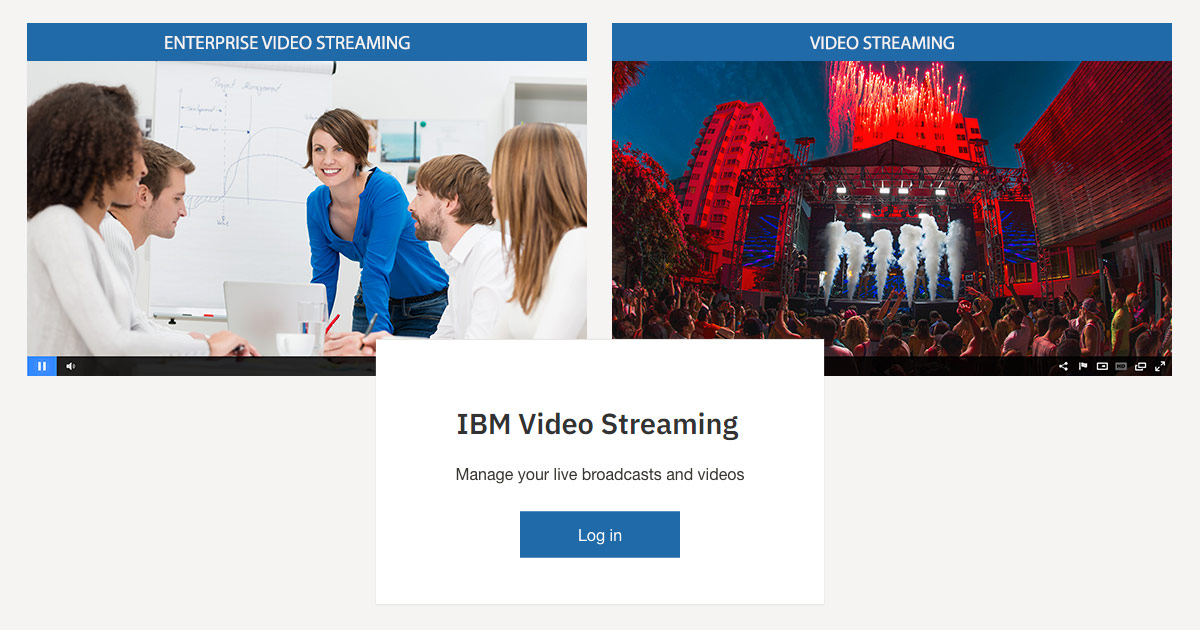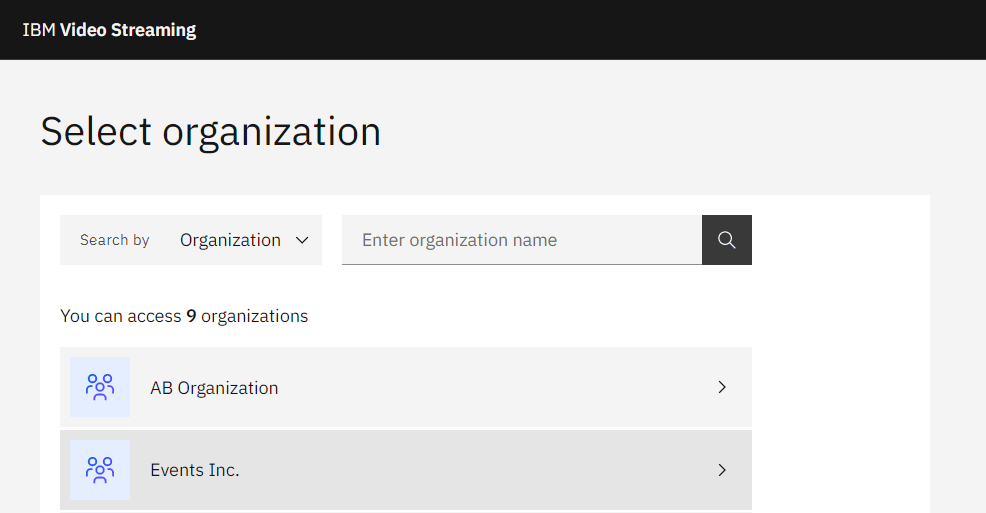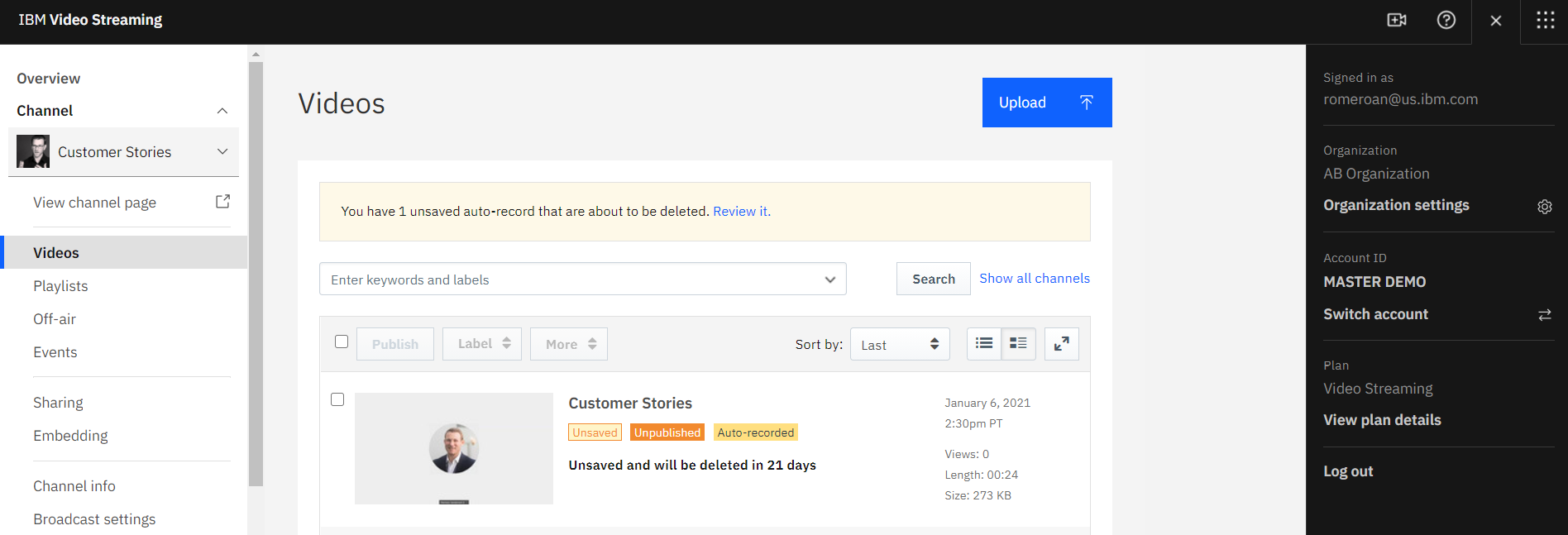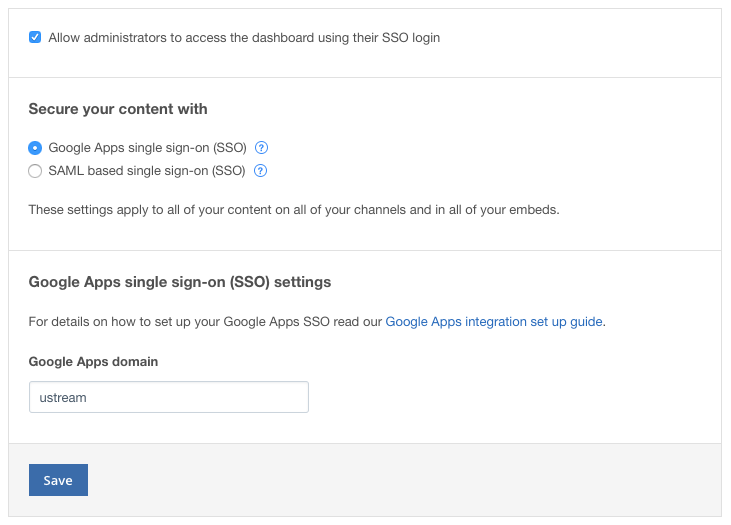
Video is shaping the way organizations do business, both internally and with customers. When surveying over 1,500 executives, Wainhouse Research discovered that over 81% describe online video as an effective tool for communicating work-related information. At the same time, dramatic shifts are happening within marketing toward video applications. In fact, by 2014, 93% of marketing professionals were using video content for online marketing.
This creates a situation where video is widely used amongst employees, but also used to drive and engage prospects. IBM created services to address both of these needs, although they exist in separate products. This added additional work and extra coordination from those who might work cross functionality for their companies video needs. To address this, IBM has introduced an organization feature for video platform management. This allows administrators to access both accounts, video streaming and enterprise video streaming, and also quickly switch between them if they need to shift from an internal to external activity. In addition, the organization feature launches with an expansion to the login process through the introduction of SSO (Single Sign-on) administration access. This allows individuals to login and begin managing their accounts using the same login credentials they use for other applications at their job. Ultimately, these changes simplify managing a company’s streaming activities, while also giving an easier, safer way to access
- Video platform management: organization level
- Accessing accounts through an organization
- Organization settings
- SSO admin access
- Organization level use cases
Video platform management: organization level
An organization is a way to join multiple accounts together. These can be as dynamic as mixing an IBM Video Streaming account with a IBM Enterprise Video Streaming account, allowing selected administrators to quickly switch between the two, to combining multiple accounts of similar function. For example, if each office in your organization had its own account, but selected administrators needed a way to go in and manage the content there. To achieve this, these accounts could all be linked to one organization, allowing these administrators to quickly switch between the accounts as needed while others might have a more gated experience confined to just the account at their office.
In addition, administrators can belong to more than one organization as well. So accounts can be grouped into organization levels by units, different companies or functions as well.
Accessing accounts through an organization
Once an organization is created, an extra layer will be added called an organization view. This view is accessed when someone, who has admin or manager rights to multiple accounts, attempts to login. After a successful login they will be greeted to a screen like below.

This view can contain multiple accounts or even multiple organizations, each with sub-accounts. In the example above, this user has access to two organizations, with one of those organizations containing both an internal facing and external facing account. The difference between these types of accounts are noted in the icons.
![]() Internal accounts, which are IBM enterprise video streaming accounts, contain restricted content. They are represented by a player with a lock icon. Video content inside these accounts is secured for their intended audiences, such as employees at an enterprise. These restriction features can range from email verification to more sophisticated integrations with SSO (Single Sign-On), the latter catering to not just protecting the content but also ease of use for those trying to access materials as well. For more details on securing this content, read our Enterprise Video Security Components white paper.
Internal accounts, which are IBM enterprise video streaming accounts, contain restricted content. They are represented by a player with a lock icon. Video content inside these accounts is secured for their intended audiences, such as employees at an enterprise. These restriction features can range from email verification to more sophisticated integrations with SSO (Single Sign-On), the latter catering to not just protecting the content but also ease of use for those trying to access materials as well. For more details on securing this content, read our Enterprise Video Security Components white paper.
![]() External accounts, IBM video streaming accounts, generally offer content aimed at a larger audience. This content can still be restricted, although this is achieved through methods like password protection or geo-blocking. It’s usually content specific, or built with broad exceptions in mind, where as internal content is to a much more finely controlled audience. In terms of use case, this makes it more ideal for marketing or entertainment events, tapping into the immense scalability of the solution as documented in this scalability white paper.
External accounts, IBM video streaming accounts, generally offer content aimed at a larger audience. This content can still be restricted, although this is achieved through methods like password protection or geo-blocking. It’s usually content specific, or built with broad exceptions in mind, where as internal content is to a much more finely controlled audience. In terms of use case, this makes it more ideal for marketing or entertainment events, tapping into the immense scalability of the solution as documented in this scalability white paper.
Once a user selects the appropriate account, they are dropped into it. Those who have used IBM video streaming accounts in the past will recognize this view as it remains largely unchanged. However, as part of an organization, users can also switch quickly between the various accounts. This is done through clicking the person icon, seen in the upper right, and going to switch accounts, as seen below.

Clicking this will cause the organization view from earlier to expand, allowing the user to change to a different account. Note that the organization view does not direct the user to a new page unless they click on a different account. The advantage being that if a user accidentally clicks here, they won’t be navigated away from what they were currently working on.
Organization settings
Organizations can be customized in several ways, controlled by clicking the “organization settings” link below each organization’s name for those who have access. Once selected, these settings are broken into:
- General Settings
The first selection here is quick, and allows users to change the name of the organization. This name will appear for other administrators and managers who have access to the organization. However, it will not be reflected to content that regular viewers will see.
 SSO Login
SSO Login
This setting controls the Single Sign-on for admins feature as it relates to your organization. If enabled, administrators can access the organization dashboard using their SSO login. The account can also be setup to utilize Google Apps or a SAML based solution, such as OneLogin or Okta.
- Administrators
The final setting controls the administrators on the account. This includes being able to see current administrators, adding admins and also revoking access as needed.
SSO admin access
There are a variety of reasons for why a company would utilize an SSO approach. These can include reducing help desk costs, avoiding the prevalent calls to assist with reseting a password, to less prevalent benefits like ideally boosting security. The latter is achieved through the ideal that because SSO allows users to remember only a single password, it will be easier to encourage the use of strong passwords. Furthermore, it will also help toward keeping passwords confidential, with the idea being to avoid scenarios where employees keep a notepad near their desk that lists their numerous passwords or other security red flags.
IBM already includes support for SSO for viewers through its enterprise video streaming solution. Now, though, IBM video streaming users can also setup their accounts to be accessible and managed through SSO as well. This negates the need for a unique login, while accounts can be setup to use the very same authentication they use for their viewers or a different method if preferred.
Only authorized individuals can access the account; in fact, even IBM’s customer support can not access the account without being given prior approval. In addition, activity by admins is tracked through audit logs, letting companies see how active their administration team is.
Organization level use cases
The organization level adds more capabilities within a single login interface. Some of these are more obvious, while others are a little bit more outside of the box, such as supporting account resellers.
Mixing External and Internal Streaming
The most overt use case is mixing video streaming and enterprise video streaming accounts under a single organization umbrella. This makes it easy for video staff within a company to manage, for example, an internal executive town hall and then quickly change gears to broadcast an external product launch as well. It can greatly assist in simplifying the management of live and on-demand video content by removing the headache of having to log out and log back in again to manage these separate accounts.
Multi-office Coordination
The organization level can extend beyond just combining video streaming and enterprise video streaming into a single login, though. It can also be used to weave together many different accounts that might be associated with different activities within the same organization. For example, an office within an organization might have its own product and its own marketing efforts, versus another office with a different product and different marketing activities related to supporting that product. In this case, both could be given their own IBM Video Streaming account and could run their own activities from it. However, there might be overlapping responsibilities, like a team of video professionals at the company, which would be given access to both at the organization level and with the ability to easily switch between them as well.
Reselling Accounts
Managing the stream activities of several schools? Overseeing a large group of churches with their own accounts? Selling streaming services for different enterprises?
The organization level presents a nice way to keep these activities organized while also giving individuals their own “walled off” account. This removes reseller dangers like one customer seeing content related to a different customer while still giving them a way to login and manage aspects of the service themselves. For resellers that are doing all the legwork, for example only giving their clients the stream information for the encoder so they can broadcast, the organization level still includes benefits for them. For example, it will be much easier to get analytics for an account’s activities or to use viewer tracking features. Those viewer tracking features can benefit both internal use cases, such as tracking completion rates for compliance training, and external use cases, such as qualifying leads through see their engagement with assets.
Summary
The organization feature simplifies internal processes for managing video content, while still allowing for flexibility in delivery and management of assets. It allows users to quickly change between an internal facing enterprise video platform to an external facing live event streaming solution. Want a group of employees to be in charge of their departments training material? Need engineers to work cross functional across accounts to manage resources? The organization feature aims to address this while the SSO admin access makes it simpler for admins to login to accounts.
Interested in expanding your video strategy and looking for some advice to take advantage of the organization approach? Read our Definitive Guide to Enterprise Video eBook to get some inspiration and unlock some of the innovation happening around online video delivery.